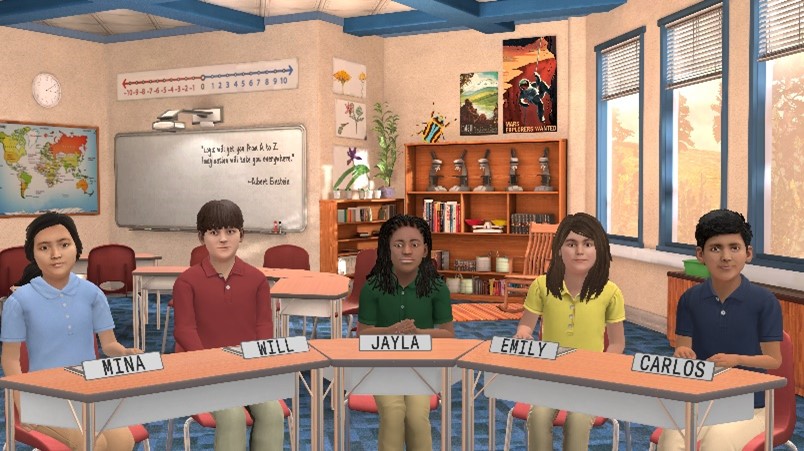Jamie Mikeska, Senior Research Scientist, Educational Testing Service (ETS)
 Ensuring that all students have substantive opportunities to engage in equitable sensemaking within STEM classrooms is critically important. But for teachers to learn how to create and maintain this kind of classroom culture, they need opportunities to engage in repeated practice where they can refine their instructional decision-making and capabilities. Simulations are one promising tool that are increasingly being used within teacher education settings to support STEM teacher learning.
Ensuring that all students have substantive opportunities to engage in equitable sensemaking within STEM classrooms is critically important. But for teachers to learn how to create and maintain this kind of classroom culture, they need opportunities to engage in repeated practice where they can refine their instructional decision-making and capabilities. Simulations are one promising tool that are increasingly being used within teacher education settings to support STEM teacher learning.
Outcomes from a recent national conference, which was funded by the National Science Foundation (grant #1813476) and focused on examining the role of simulations in mathematics and science teacher education, resulted in a published manuscript that included the following working definition of simulations for use in STEM teacher education contexts:
Simulations are responsive learning spaces where pre-service and in-service teachers can rehearse critical instructional practices or specific skills essential to the work of teaching in situations of reduced complexity. These learning spaces can target the interactive, in the moment, responsive work of teaching, such as eliciting student ideas or facilitating student-led discussions, or the non-interactive components, such as planning, grading, providing written feedback on work, or interpreting student data. Simulations do not involve interactions with real students; instead, they typically involve synchronous and human-driven interactions, where the participant interacts via a face-to-face format or through a technologically mediated environment with one or more adults who act as K-12 students.
Two of the most common types of simulations involve: (a) face-to-face rehearsals where a teacher’s colleagues or peers act as K-12 students while they practice teaching or (b) digital simulated teaching experiences where teachers interact with one or more student avatars in a simulated classroom environment, such as Mursion’s upper elementary simulated classroom.

While the specific features of simulations may vary across simulation models and use cases, there are many benefits to using simulations to support STEM teacher learning. One frequently mentioned benefit is that simulations provide practice-based spaces for teachers to try out novel instructional skills and approaches that are critical to the work of teaching and refine them through repeated practice. Simulations also create safe spaces where teachers can make mistakes without causing any harm to real students. They can also be used to provide opportunities for teachers to practice teaching in settings of reduced complexity, as the teacher educator can design the scenario used in the simulation to focus on a specific teaching challenge or teaching competency, such as learning to facilitate discussions or encourage students to draw upon their life experiences within STEM classrooms, without having to contend with the full complexity of classroom teaching. And not only can simulations develop STEM teachers’ ability to engage in specific teaching practices, but they have also been shown to develop STEM teachers’ knowledge, their professional vision and identity, their beliefs and orientations, and their ability to work with special student populations.
Using simulations to support STEM teacher learning also comes with challenges. One key challenge that teacher educators face is how to best integrate simulations within varied professional learning settings to adequately address teachers’ learning needs. Part of this challenge involves attending to the larger cycle of enactment and determining how teacher educators can support teachers’ collective and substantive preparation for, engagement in, and reflection on the simulated teaching experience. Another challenge is helping to manage and address teachers’ emotional responses when using simulations as they likely will face new teaching challenges and such environments, especially digital ones, may be unfamiliar to teachers. A final challenge relates specifically to the use of digital simulations – as teacher educators need to ensure that all teachers have equitable access to these technological tools, which requires adequate equipment and a stable internet connection to interact with student avatars in a simulated classroom online.
Simulations are one possible tool that teacher educators can leverage in their work with preservice and in-service teachers, although they are not a panacea to address every problem of practice that teachers may experience. Making progress in this area requires a collective effort across researchers to conduct studies that help us better understand under what conditions, for what purposes, and for whom simulations can be leveraged as useful tools to support STEM teacher learning. The field would also benefit from studies that work to connect the dots between the use of simulations to support STEM teachers’ learning within teacher education and professional development contexts and teachers’ application of their simulation-based learning in the work they do within actual K-12 classrooms, as well as studies that examine the varied factors that support and hinder the productive use of simulations in these contexts. Finally, as we look to the future, cross-functional research teams can address scalability challenges in this space by exploring how artificial intelligence, machine learning, and natural language processing can be used to develop automated scoring and feedback models and engineer fully automated online simulated environments to support STEM teacher learning.